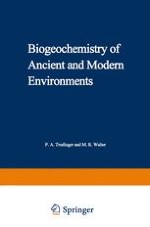1980 | OriginalPaper | Chapter
Consequences of Anaerobiosis on Metal-Organic Interactions in Two Ponds of the Southeastern United States
Authors : J. J. Alberts, B. J. Collins
Published in: Biogeochemistry of Ancient and Modern Environments
Publisher: Springer Berlin Heidelberg
Included in: Professional Book Archive
Activate our intelligent search to find suitable subject content or patents.
Select sections of text to find matching patents with Artificial Intelligence. powered by
Select sections of text to find additional relevant content using AI-assisted search. powered by
Naturally occurring organic matter is known to complex cations (Schnitzer and Khan, 1972). However, there are differing opinions as to the importance of organic matter binding of metals compared to inorganic ligand binding (Stumm and Morgan, 1970). Ramamoorthy and Kushner (1975a,b) have suggested that organic matter is an important component of the binding capacity of certain rivers for Hg2+, Cu2+, Pb2+. Sunda and Hanson (1979) have demonstrated that organic complexes are the principal forms of soluble copper in rivers. Giesy et al. (1978) showed a large effect of organics on Cu2+ and Pb2+ in the binding capacities of several surface waters in Maine, but no significant effect of organics in the binding capacities of European waters (Giesy and Briese, 1980). Finally, Schindler and Alberts (1975) in a study of Par Pond determined that humic type organics were relatively unimportant in this system for the removal or burial of cations, but may play a role in redox reactions of certain metals.
